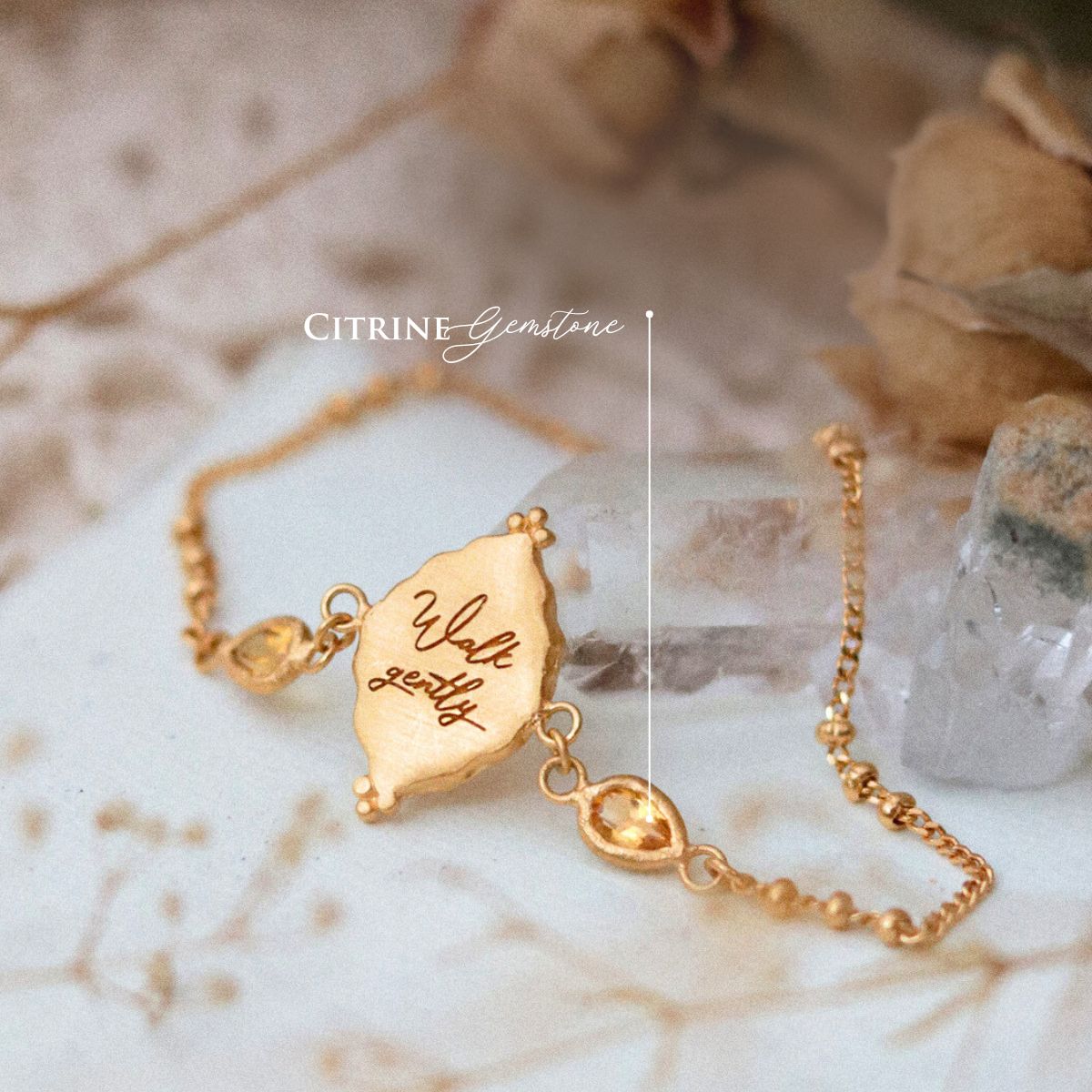
Unveiling the Radiance: Origins of Citrine
Citrine is a form of quartz that is beautifully transformed into a vibrant yellow color by the earth's deep forces. Its name comes from the French word "citron," meaning lemon, perfectly describing its sunny appearance. Let's take a journey into the origins and composition of this dazzling gemstone.
- How is citrine formed? The journey of citrine begins deep within the earth's core, where it is born from heat and pressure. This gemstone is a variety of quartz, a mineral found abundantly in the earth's crust. When amethyst, a type of quartz, is heated by the earth's natural processes, it transforms into citrine and acquires its unique color and energy.
- What gives citrine its color? Amethyst is a purple variety of quartz, but when heated, the iron particles in its composition adopt a warm yellow to reddish-orange color, transforming into the gemstone we know as citrine. The intensity of its color can vary from a pale yellow to a deep golden hue, depending on the amount of heat and pressure it has been subjected to.
- Where is citrine found? We can find citrine in many regions around the world, including Brazil, Madagascar, Zambia, Scotland, Russia, and Spain. When mined, it is often found in clusters or masses rather than individual crystals. This makes it a popular choice for use in jewelry, as it can be cut into various shapes and sizes to fit different designs.
- When was citrine first discovered? Citrine was already highly valued by ancient civilizations. The beauty of this stone and its seeming connection to the sun led to its widespread use in amulets and talismans by ancient Egyptians, who believed it got its color from Ra, the God of the Sun. The Greeks and Romans used it as jewelry, thought to bring prosperity. A Spanish conquistador in the 1600s first documented citrine found in the Bolivian mine, "Anahí," and over time, citrine's popularity continued to surge.
- How rare is citrine? Naturally occurring citrine is considered to be a relatively rare and valuable gemstone. Most of the citrine available in the market is heat-treated amethyst, which can be found more easily and for a lower price pointt. However, all-natural citrine is still prized for its unique color and energy.
From the fiery depths of the earth to the radiant light of the sun, citrine encapsulates the wonder of nature's creations. And as we wear it, we carry a piece of this wonder with us, a constant reminder of the earth's splendor and the sun's warm embrace.
Energetic Symphony: Citrine and Chakra Healing
Citrine is more than just a dazzling gemstone; this sunny crystal also possesses powerful healing properties. It works with the chakras, the energy centers of the body, to bring balance and harmony to our physical, emotional, and spiritual well-being.
Citrine, with its sunlit splendor, is often associated with the Solar Plexus Chakra, the energetic center located in the upper part of the belly where our diaphragm rests. This chakra, also known as Manipura or Third Chakra, is the wellspring of personal power, self-esteem, and expression. It's the seat of our inner fire, the flame that fuels our ambition and drives our willpower. That's why citrine is known as the power stone, believed to enhance confidence, creativity, and motivation.
When the Solar Plexus Chakra is in harmony, we stand tall, radiant with self-confidence, and warmed by the inner glow of self-acceptance. But when this chakra is out of balance, our inner light dims, and we may feel powerless, insecure, and hesitant. This is where the energetic healing of citrine comes into play.
Just as the sun dispels the shadows of the night, citrine, with its warm, golden glow, helps banish the darkness of self-doubt and insecurity. It carries the energy of the sun within it, radiating positivity and courage. When introduced into chakra healing practices, citrine acts like a tuning fork, helping to bring the Solar Plexus Chakra back into harmonic resonance.
But the healing powers of citrine do not stop there. Citrine also resonates with the Sacral Chakra, or Svadhishthana, which is responsible for our emotional and sexual energy. When this chakra is balanced, we experience a sense of inner peace and healthy relationships. Citrine can help to release any blockages in this chakra, allowing us to tap into our natural sensuality, creativity, and emotional intelligence.
Citrine's ability to work with multiple chakras makes it a valuable tool for overall well-being and spiritual growth. It can help to align all the chakras, creating a harmonious flow of energy throughout the body.
To boost your Solar Plexus Chakra, place a citrine gemstone on the upper abdomen, lie down in a relaxed atmosphere, visualize the color of your citrine, and soak up the serenity.
As you meditate with citrine, envision its golden light filling your Solar Plexus Chakra, stoking your inner fire, and kindling your personal power. Feel the warmth spread through your being as if you are basking in the morning sun, absorbing its energy and vitality.
You can also hold a citrine crystal in your hand while you meditate. Alternatively, you can wear citrine jewelry, such as a necklace or bracelet, to carry citrine’s healing properties with you throughout the day.
The practice of chakra healing with citrine is not just about balancing energies; it's a journey of self-discovery. It's about acknowledging our inner light, nurturing our personal power, and allowing ourselves to shine with unabashed brilliance.

The Visual Poetry: What Citrine Looks Like
Citrine's sunny color and sparkling appearance make it a beloved gemstone for jewelry making. Its warm golden hue is reminiscent of autumn leaves, adding warmth and radiance to any outfit. This dazzling gemstone also has a unique visual poetry that begs to be admired.
Citrine is part of the quartz family, which means it has the same crystal structure as other popular gemstones like amethyst and rose quartz. However, citrine's color sets it apart from its cousins.
Its yellow to golden-hue varies depending on the trace elements present during its formation, resulting in a spectrum of colors ranging from a light lemony yellow to an earthy brown with delightful shades of orange in between.
The intensity of color greatly influences the value of each citrine gemstone, and an even tone throughout enhances the allure of this gemstone. For example, a deeply saturated reddish-orange citrine is highly prized and often referred to as Madeira citrine after the wine, even though it generally comes from Brazil. It is a rare and valuable gemstone that can fetch high prices in the market.
Citrine's visual poetry goes beyond its color; its clarity also plays a significant role in its appeal. Most of the citrine sold is what is called "eye-clean," meaning it has no visible inclusions to the naked eye. You have to look under the microscope to see any imperfections.
Inclusions are minuscule traces of other minerals or tiny fractures that were healed during the gemstone's formation. Far from being imperfections, these inclusions are the verses in Citrine’s visual poem, adding character and depth to its beauty.
One way to tell authentic citrine from fake or treated stones made to look like citrine is by checking for inclusions. If the gemstone appears too clear and perfect, it is likely not authentic. Whether you're drawn to citrine for its vibrant color or its unique clarity and character, this gemstone's visual poetry is sure to delight and inspire.

Cleansing and Care: Preserving Citrine's Splendor
Just like any other gemstone, citrine needs to be cleansed and cared for to maintain its energetic properties and visual splendor. Over time, our crystals can absorb negative or stagnant energy from their surroundings or the people handling them. Cleansing your citrine regularly ensures it stays energetically pure and potent and maintains its shining glory.
The journey of caring for your citrine begins with understanding its nature. Citrine, a variety of quartz, is a relatively hard and durable gemstone, ranking seven on the Mohs scale of hardness. This makes it suitable for jewelry, and it can tolerate everyday wear and tear. However, it's still important to take precautions when handling your citrine jewelry to avoid it getting scratched.
Here are the steps to clean your citrine gemstone or jewelry:
- Hold your citrine under running water for a few minutes. You can hold it between your fingers or place it in a strainer or colander. Water has the natural ability to cleanse and purify, so it's excellent to remove any negative or stagnant energy.
- Wash the citrine with mild soap and water, gently rubbing it to remove any dirt or remaining impurities. Rinse it well under running water.
- Avoid using harsh chemicals or abrasive cleaners such as bleach, chlorine, or ammonia, as they can damage the surface of your citrine and cause deterioration or discoloration of the gemstone over time.
- Dry your citrine with a soft, clean cloth, or let it air dry. Do not rub too hard, as this may cause scratches. Make sure it is completely dry before storing it.
As well as keeping your citrine clean from any dust or impurities, you want to make sure that you also cleanse any stagnant or negative energy from it and recharge it energetically. If you want to know how to cleanse citrine, here you have a few different ways to do this:
- Place your citrine in a bowl of dry sea salt and leave it for 24 hours to absorb any unwanted energies. Be sure to rinse the citrine under running water to remove any remaining salt.
- Alternatively, you can cleanse your citrine using sage or palo santo smoke. Simply hold the citrine in the smoke and visualize any negative energy being released from the gemstone.
- You can also place your citrine in natural light, such as sunlight or moonlight, for a few hours or overnight. Both the sun and moon have purifying and energizing properties that can help cleanse and recharge your citrine.
- Some people like to bury their citrine in the earth for at least 24 hours, allowing it to ground and reconnect with the earth's natural energy. It's a powerful way to reset and recharge your citrine. Just make sure you don't forget where you buried it!
Remember to remove your citrine jewelry before swimming, washing the dishes, or using any harsh chemicals or cleaning agents. Store your citrine jewelry separately from other gemstones to avoid scratches and keep it safe from any accidental impacts that could cause damage.
Caring for your citrine is more than a practical ritual; it's a spiritual journey. It's about fostering a bond with your gemstone, ensuring it retains its energetic essence and gets charged with your love and intention. With gentle care, proper cleansing, and thoughtful attention, your citrine will continue to shine and radiate its uplifting energy for years to come. So, take the time to cherish and nurture your citrine and let it be a source of inspiration and power in your life.

Citrine, with its alluring color, unique clarity, and inherent charm, is more than just a gemstone. A reflection on the sun's trays, it's a source of positive energy, a symbol of light and warmth, and an accessory that complements your style. As you wear citrine gemstone jewelry, you not only embrace the beauty of nature but also carry a piece of powerful, energetic influence. Explore the brilliance of citrine today, and let this radiant gemstone bring a touch of splendor to your everyday life.
Continue Your Chakra Journey:
Read About - Healing Gemstone for Chakra Balancing: Enhancing Mind, Body and Spirit
Read About - Spiritual Jewelry - Aquamarine Meanings, Properties and Powers
Read About - Crystal for Manifesting: How to Use Intention in Jewelry
